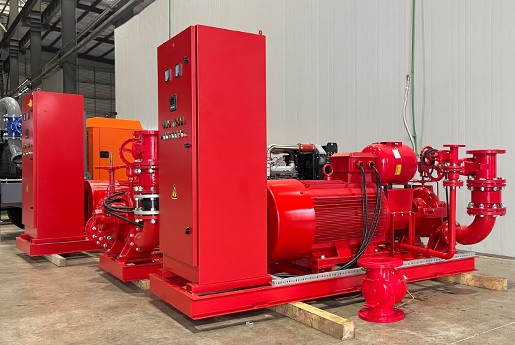-
 Nov 14, 2023Fire pump self-checking functionFire pumps are critical components of fire protection systems, and their proper functioning is crucial for ensuring the availability of water during a fire emergency. Self-checking functions in fire pumps are designed to automatically test and monitor various aspects of the pump system, ensuring that it is ready to operate when needed. Here are some common self-checking functions found in fire pumps:
Nov 14, 2023Fire pump self-checking functionFire pumps are critical components of fire protection systems, and their proper functioning is crucial for ensuring the availability of water during a fire emergency. Self-checking functions in fire pumps are designed to automatically test and monitor various aspects of the pump system, ensuring that it is ready to operate when needed. Here are some common self-checking functions found in fire pumps:
View details -
 Nov 14, 2023How to polish fire pump?Polishing a fire pump involves cleaning and restoring its external surfaces to improve appearance and prevent corrosion. Here's a general guide on how to polish a fire pump:
Nov 14, 2023How to polish fire pump?Polishing a fire pump involves cleaning and restoring its external surfaces to improve appearance and prevent corrosion. Here's a general guide on how to polish a fire pump:
View details -
 Nov 13, 2023What are the characteristics of the fire pump’s packing seal?Fire pumps commonly use packing seals as an alternative to mechanical seals. Packing seals have their own set of characteristics and considerations. Here are the key features of fire pump packing seals:
Nov 13, 2023What are the characteristics of the fire pump’s packing seal?Fire pumps commonly use packing seals as an alternative to mechanical seals. Packing seals have their own set of characteristics and considerations. Here are the key features of fire pump packing seals:
View details -
.jpg) Nov 13, 2023What are the characteristics of the mechanical seal of the fire pump?Mechanical seals play a critical role in ensuring the reliability and efficiency of fire pumps. Here are some key characteristics and considerations for mechanical seals in fire pump applications:
Nov 13, 2023What are the characteristics of the mechanical seal of the fire pump?Mechanical seals play a critical role in ensuring the reliability and efficiency of fire pumps. Here are some key characteristics and considerations for mechanical seals in fire pump applications:
View details -
 Nov 10, 2023Common faults of fire pumpsFire pumps are critical components of fire protection systems, and any faults or malfunctions can compromise the system's effectiveness during an emergency. Common faults of fire pumps include:View details
Nov 10, 2023Common faults of fire pumpsFire pumps are critical components of fire protection systems, and any faults or malfunctions can compromise the system's effectiveness during an emergency. Common faults of fire pumps include:View details -
 Nov 09, 2023Installation of diesel engine fire pumpThe installation of a diesel engine fire pump is a critical component of a fire protection system, and it must be done in accordance with local building codes, industry standards, and the manufacturer's recommendations. Below are the general steps involved in installing a diesel engine fire pump:
Nov 09, 2023Installation of diesel engine fire pumpThe installation of a diesel engine fire pump is a critical component of a fire protection system, and it must be done in accordance with local building codes, industry standards, and the manufacturer's recommendations. Below are the general steps involved in installing a diesel engine fire pump:
View details

.png)

.png)


